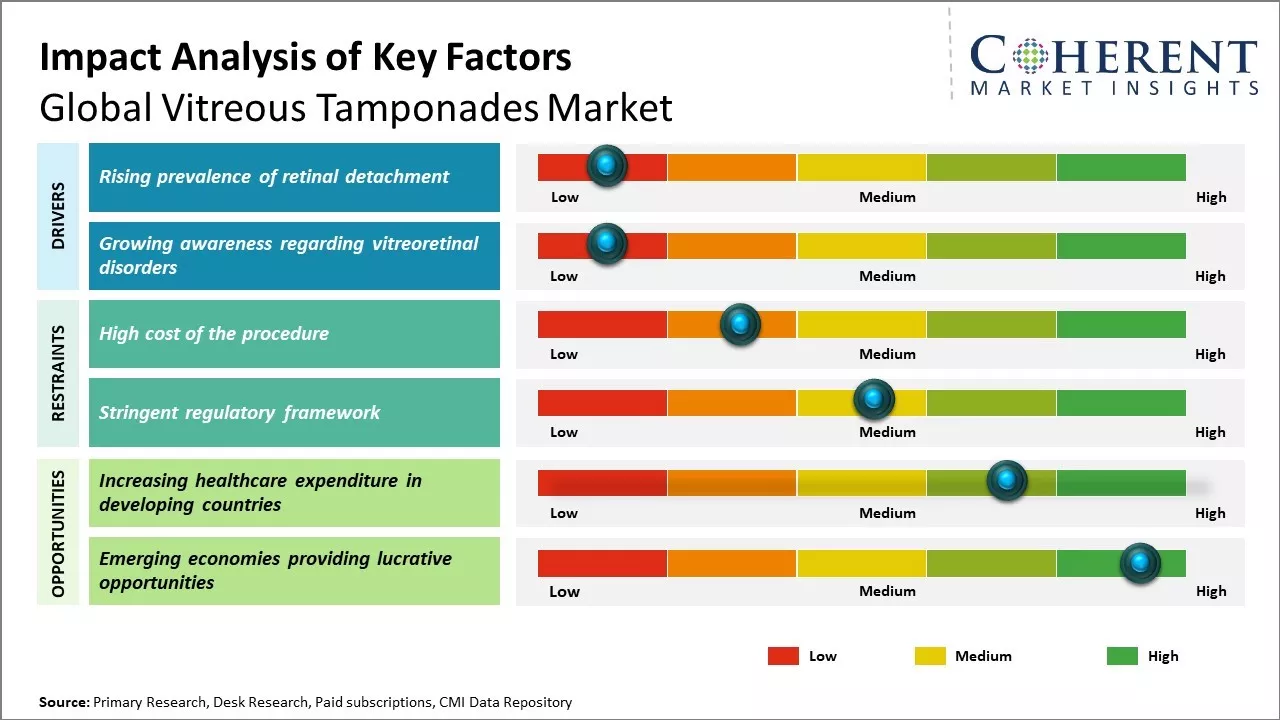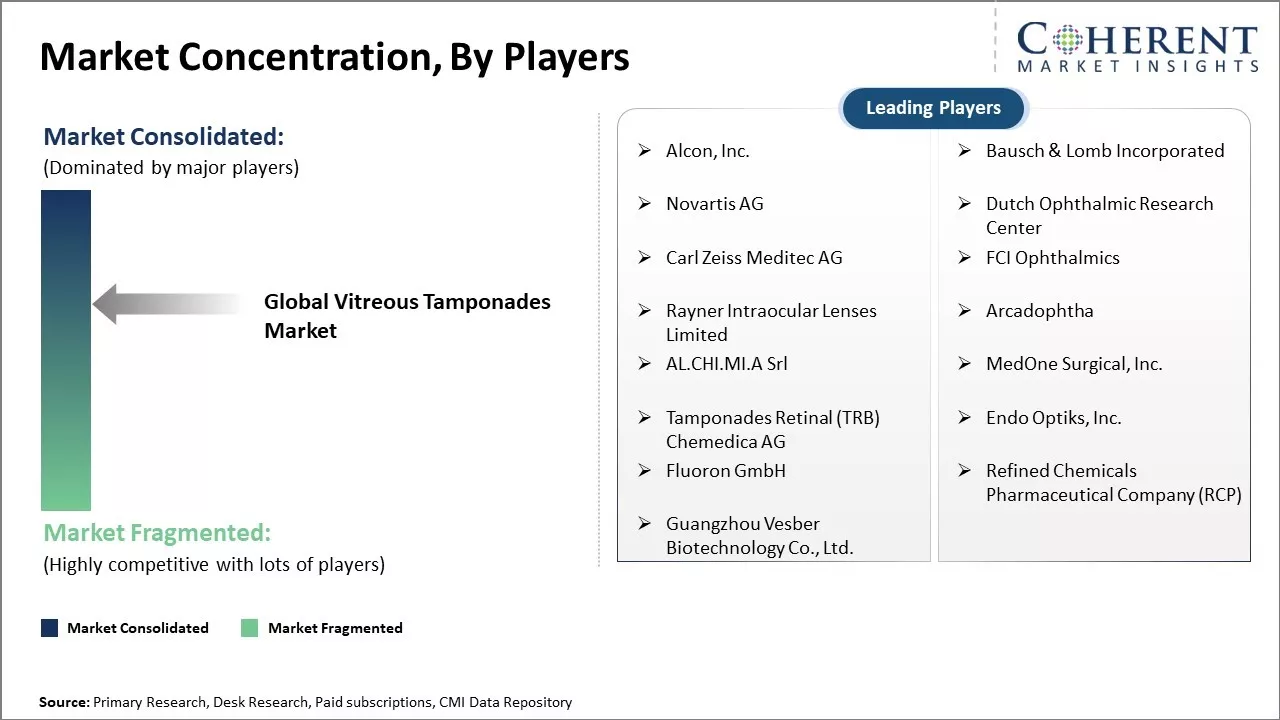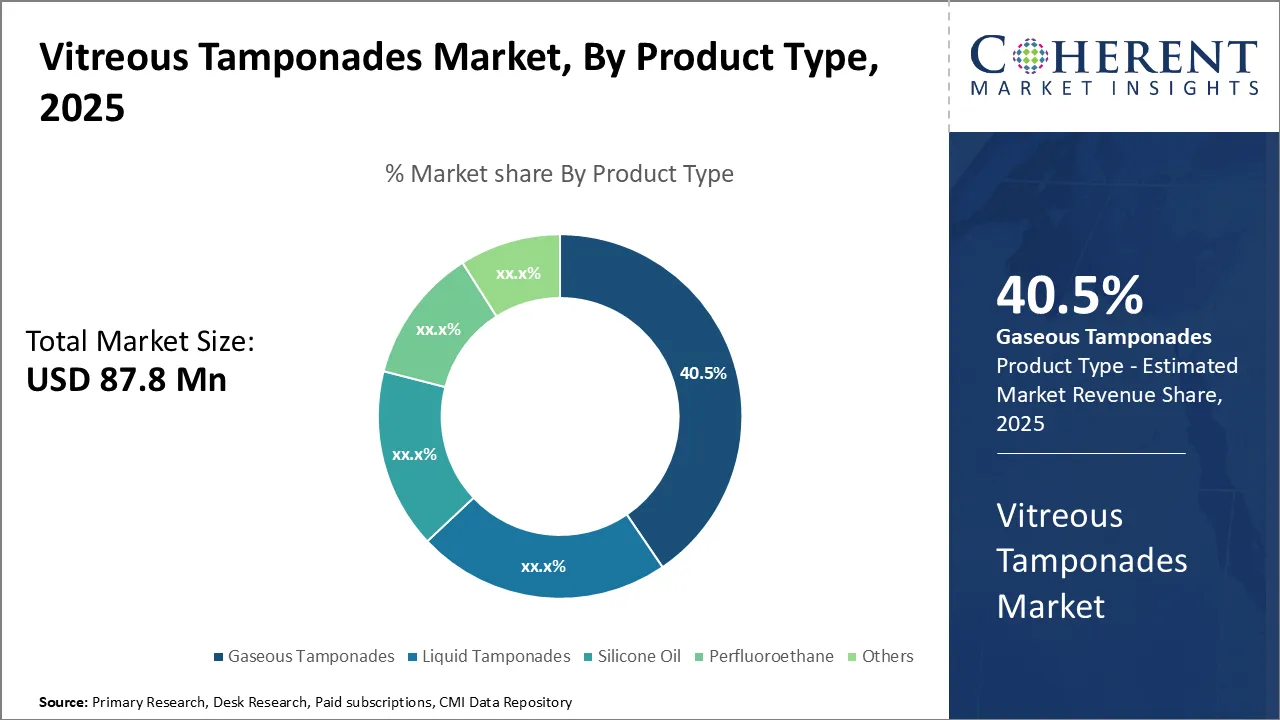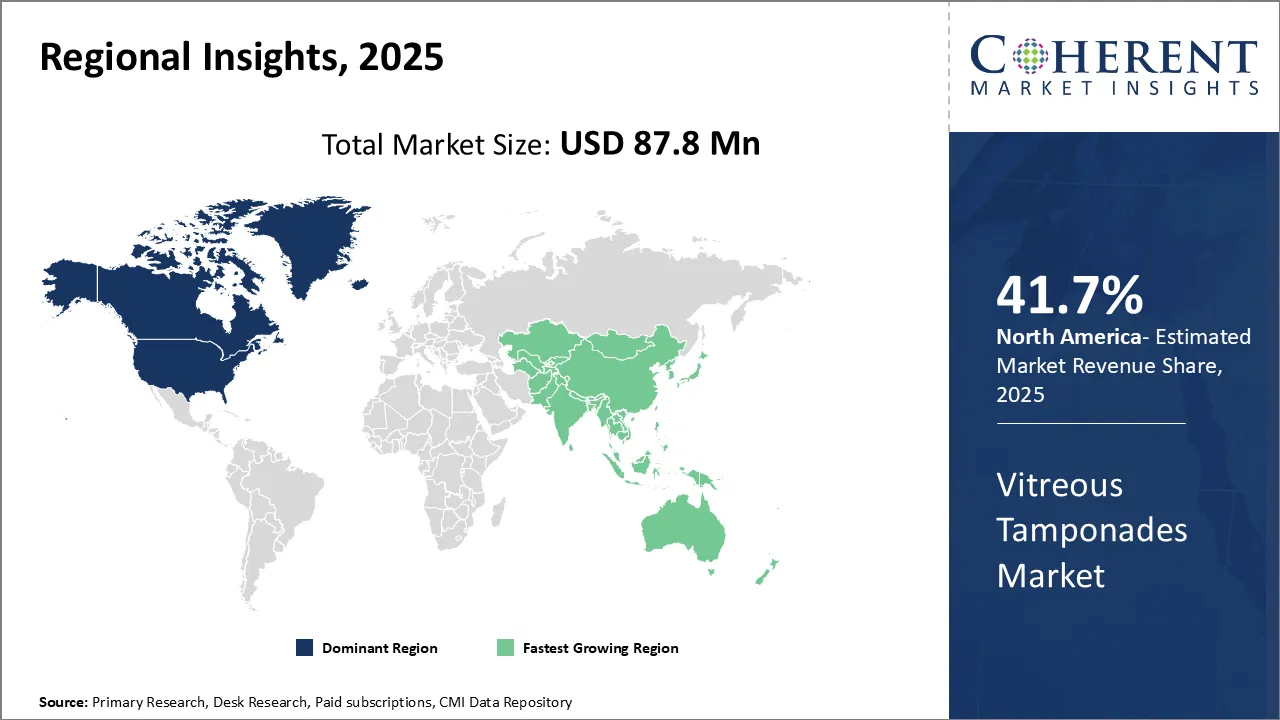Global vitreous tamponades market is estimated to be valued at USD 87.8 Mn in 2025 and is expected to reach USD 113.4 Mn by 2032, exhibiting a compound annual growth rate (CAGR) of 3.7% from 2025 to 2032. Rising prevalence of ophthalmic disorders and increasing incidence of retinal detachment across the globe can boost demand for vitreous tamponades in surgical procedures.

Discover market dynamics shaping the industry: Request sample copy
Growing elderly population who are more prone to developing retinal disorders can drive the market growth. Furthermore, ongoing research and development activities for developing advanced and long-lasting tamponades can offer new growth opportunities to market players.
Rising prevalence of retinal detachment
Rising prevalence of retinal detachment cases across the globe can drive the global vitreous tamponades market growth. Retinal detachment occurs when the retina peels away from its underlying layer of tissues called retinal pigment epithelium. It is a potentially blinding condition that needs immediate medical attention and often requires surgery. A According to the data published by U.S. National Eye Institute, about 1 in 10,000 people every year experience a retinal detachment in the U.S. The risk increases with age, high nearsightedness, eye injury, and certain health conditions like diabetes. With overall growing global population and longer life expectancy, especially in developed countries, there has been increase in number of elderly individuals who are more prone to retinal detachment. As per the data published by United Nations, the population aged 65 years or over is projected to increase from 727 million in 2020 to 1.5 billion in 2050 worldwide. This demographic shift can increase the prevalence of retinal detachment cases, thus, boosting demand for vitreous tamponades. Vitreous tamponades act as an internal bandage helping seal retinal breaks and flattening the detached retina against the retinal pigment epithelium during retina reattachment surgery.

Get actionable strategies to beat competition: Request sample copy
Growing awareness regarding vitreoretinal disorders
Growing awareness about vitreoretinal disorders and their treatment options can drive the global vitreous tamponades market growth. Various vision impairment organizations and nonprofit eye care providers across the world have intensified their efforts to educate people about various retina-related conditions like retinal detachment, macular pucker/hole, and proliferative vitreoretinopathy. This has translated to more patients seeking medical attention at early stages. Furthermore, advancements in ophthalmic surgery techniques with the aid of improved tamponade agents have boosted the clinical outcomes for vitreoretinal procedures. Temporary tamponades like silicone oils and long-acting gas bubbles help surgeons achieve longer lasting retinal reattachment during complex retinal detachment repair. In 2021, according to the report published by the International Agency for the Prevention of Blindness, over 1.1 million vitrectomy surgeries were performed worldwide for various vitreoretinal disorders. A major portion of these procedures utilized some form of internal tamponade to seal retinal breaks. There will be huge demand for safer and more durable tamponades as more premium IOLs and pharmacologic vitreolysis agents become available. Surgeons would prefer agents that minimize recurrent retinal detachment risk as well as complications like elevated intraocular pressure and cataract formation.
Key Takeaways from Analyst
The global vitreous tamponades market is expected to witness steady growth over the forecast period. An aging population that is more susceptible to eye conditions like retinal detachment is a major driver augmenting demand for vitreous tamponades. Additionally, the rising incidence of eye injuries and diseases across the world, especially in developing nations will boost market expansion. Further, technological advancements in vitrectomy equipment combined with growing preference for minimally invasive surgeries are fueling adoption of vitreous tamponades.
However, stringent regulations pertaining to the approval of new products might restrain market growth. High costs of vitrectomy surgeries act as a barrier, especially in price-sensitive developing markets. The lack of awareness about vitreous tamponades in rural areas also hinders market penetration.
The Asia Pacific region excluding Japan holds immense growth opportunities owing to its large patient population and improving healthcare expenditures. The North America market maintains its dominant position and is expected to witness steady demand due to favorable reimbursement policies. Among tamponade types, silicone oil and perfluorocarbon leads the segment. Ambulatory surgical centers have emerged as key end-users performing high volumes of retinal repair procedures annually.
Market Challenges: High cost of the procedure
The cost of vitreous tamponade procedures acts as a significant barrier limiting market expansion. Vitreous tamponade surgery involves use of specialized equipment, drugs and highly skilled personnel. The average total cost of a basic vitrectomy procedure ranges between $5,000 to $10,000 in major markets like the United States according to data from the National Center for Biotechnology Information (NCBI). For more complex cases requiring prolonged surgery and advanced tamponades like silicone oils or perfluorocarbon liquids, costs can escalate over $20,000. Given the elective nature of most vitreous tamponade procedures, patients are sensitive to out-of-pocket costs. This deters them from undergoing surgery, especially in developing regions where public healthcare is limited. The Covid-19 pandemic has also widened healthcare inequities and reduced affordability of elective procedures globally according to the WHO.High costs disproportionately impact populations in greatest need. Globally, over 185 million people are estimated to be living with vision impairment due to diabetic retinopathy according to the International Diabetes Federation (IDF). Many developing countries have large diabetic populations but lack affordable access to advanced retinal care due to the financial burden. This leaves vast numbers untreated and susceptible to eventual vision loss. Unless public funding improves or innovative low-cost models are adopted, the socioeconomic barriers posed by procedure expenses will continue restricting the full potential of the vitreous tamponades market globally, especially in low and middle-income regions.
Market Opportunities: Increasing healthcare expenditure in developing countries.
Increasing healthcare expenditure in developing countries provides significant opportunities for global vitreous tamponades market growth. As developing nations experience rising incomes and better access to healthcare insurance, their governments and citizens are able to invest more in medical services and technologies. Many developing countries in regions like South Asia, Latin America, Middle East and Africa have witnessed exponential increase in healthcare spending over the past decade as a percentage of their GDP. For example, according to World Bank Data, healthcare expenditure as a percentage of GDP had increased from 4.2% to 5.4% in India between 2015-2020. . Similar trends are found in other populous developing nations such as Brazil, Indonesia and Nigeria where governments have prioritized healthcare reforms and infrastructure development. As more resources go into establishing specialized hospitals and surgical centers in these regions, the demand for advanced ophthalmic devices and medicines increases rapidly. Vitreous tamponades are widely used in retinal detachment surgeries, which are becoming more common as diagnostic capabilities and public awareness about eye diseases improve even in smaller towns and cities. This leads to greater uptake of high-quality silicone oils, perfluorocarbon liquids and gases that are used as vitreous substitutes during such surgeries.

Discover high revenue pocket segments and roadmap to it: Request sample copy
By Product Type- Growing Preference for Temporary Nature Drives Gaseous Tamponades Segment
In terms of product type, gaseous tamponades segment is estimated to contribute the highest market share of 40.5% in 2025, owing to their temporary nature. Gaseous tamponades such as C3F8, SF6 are preferred over liquid tamponades as these get absorbed naturally within 2-3 months without requiring any removal surgery. This reduces costs and risk of complications for patients. Gaseous tamponades does not cause inflammation or proliferative vitreoretinopathy as rarely as silicone oils do. Their ease of use and safety profile have increased their adoption among ophthalmologists over time. Developments in gas tamponade delivery techniques through small gauge vitrectomy also contribute to the segment growth.
By Application- Increased Diagnosis Rate Fuels Growth of Retinal Detachment Segment
In terms of application, retinal detachment segment is estimated to contribute the highest market share of 30.12 % in 2025 . due to rising prevalence of retinal detachment cases owing to increasing risk factors like high myopia, ocular trauma, vitreoretinal surgeries, and others. Growing elderly population can also drive the segment growth as retinal detachment is more common in people aged over 60 years. Advancements in clinical examination technologies improves detection rate of retinal tears and breaks, thus, enabling early treatment with vitreous tamponades to reattach retina. Favorable reimbursement and awareness programs further boosts the segment growth.
By End User - Higher Budget Allocations Favor Hospitals Segment
In terms of end user, hospitals segment is estimated to contribute the highest market share of 41 % in 2025 as hospitals have higher capital and infrastructure to accommodate complex retinal procedures requiring vitreous tamponades. Government in developed nations allocate larger healthcare budgets for hospitals compared to other facilities. This allows hospitals to invest in latest equipment, employ experienced surgeons and offer vitreoretinal surgeries at lower costs. Hospitals can leverage economies of scale to procure expensive tamponade products in large volumes at reduced prices. Growing preference to get specialized retinal care at hospitals rather than low-budget clinics also boosts their dominance.

Need a Different Region or Segment? Customize now
North America dominates the global vitreous tamponades market with an estimated market share of 41.7% in 2025. The strong presence of global medical device companies and strong research activities in ophthalmology has enabled early adoption of new tamponade agents. The large population opting for cataract surgeries and rising cases of retinal detachment boosts demand. Good reimbursement policies and healthcare infrastructure provides access to quality care.
Being the global innovation hub, there is continuous development of advanced vitreous tamponades. Silicone oil is extensively used in the region, owing to established safety profile and longer duration of action. However, their removal requires additional surgery that increase costs. This has opened opportunities for third generation tamponades which are shorter acting and removable tamponades without additional surgery.
Asia Pacific witness fastest growth and emerges as lucrative market. Rapid economic growth, rising healthcare standards, and growing medical tourism in countries like China, India, and South Korea can drive the market growth. These countries are investing heavily in ophthalmology and eye care infrastructure.
India is emerging as global outsourcing hub for medical devices including vitreous tamponades. Presence of low-cost skilled workforce in the country enables manufacturing of vitreous tamponades at competitive prices. Local companies as well as global ophthalmic players are establishing manufacturing facilities to cater growing regional demand.
Vitreous Tamponades Market Report Coverage
| Report Coverage | Details | ||
|---|---|---|---|
| Base Year: | 2024 | Market Size in 2025: | USD 87.8 Mn |
| Historical Data for: | 2020 To 2024 | Forecast Period: | 2025 To 2032 |
| Forecast Period 2025 to 2032 CAGR: | 3.7% | 2032 Value Projection: | USD 113.4 Mn |
| Geographies covered: |
|
||
| Segments covered: |
|
||
| Companies covered: |
Alcon, Inc., Bausch & Lomb Incorporated , Novartis AG, Dutch Ophthalmic Research Center, Carl Zeiss Meditec AG, FCI Ophthalmics, Rayner Intraocular Lenses Limited, Arcadophtha, AL.CHI.MI.A Srl, MedOne Surgical, Inc., Tamponades Retinal (TRB) Chemedica AG, Endo Optiks, Inc. , FluoronGmbH, Refined Chemicals Pharmaceutical Company (RCP), Guangzhou Vesber Biotechnology Co., Ltd. |
||
| Growth Drivers: |
|
||
| Restraints & Challenges: |
|
||
Uncover macros and micros vetted on 75+ parameters: Get instant access to report
Share
Share
About Author
Manisha Vibhute is a consultant with over 5 years of experience in market research and consulting. With a strong understanding of market dynamics, Manisha assists clients in developing effective market access strategies. She helps medical device companies navigate pricing, reimbursement, and regulatory pathways to ensure successful product launches.
Missing comfort of reading report in your local language? Find your preferred language :
Transform your Strategy with Exclusive Trending Reports :
Frequently Asked Questions
Joining thousands of companies around the world committed to making the Excellent Business Solutions.
View All Our Clients
US Reciprocal Tax Impact Analysis On Vitreous Tamponades Market
Stay updated on tariff changes with expert insights and timely information